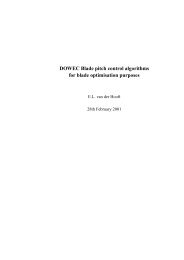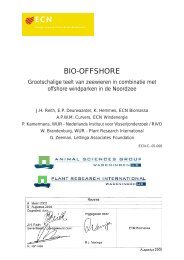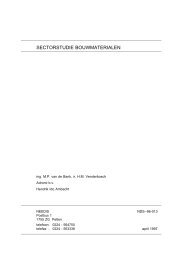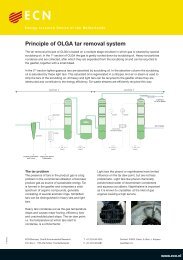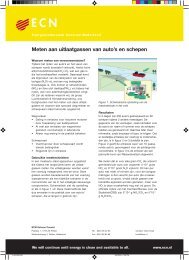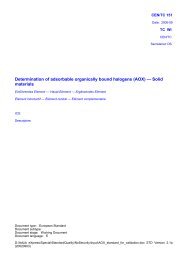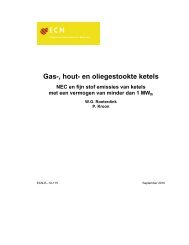PDF format (503 kB) - ECN
PDF format (503 kB) - ECN
PDF format (503 kB) - ECN
Create successful ePaper yourself
Turn your PDF publications into a flip-book with our unique Google optimized e-Paper software.
PET bottles normally are made out of virgin PET but the three layer PET bottle with a recycled PET inner layer<br />
can be seen as an improvement option. We will use the bottle with 25% recycled PET as improvement option<br />
for the virgin bottle.<br />
Liquid board<br />
Cartonboard has been used to pack liquids for a long time. The Tetra Classic was introduced as early as in 1952<br />
[PPI, 1996]. The most important markets for liquid cartonboard are milk and juice packaging. Less important<br />
are wine, water, and soup packaging [PPI, 1996].<br />
In order to hold liquids liquid board is laminated with other materials like PE and aluminum. Tetra Briks for<br />
juice packaging for example contain 75% cardboard, 20% PE and 5% aluminum and the total weight is 28<br />
grams for a 1 liter package [Buelens, 1997]. Cardboard is used as middle layer with a PE and aluminum layer<br />
on the inside and a PE outer layer. The liquid board package is not expected to undergo radical changes in future<br />
years. To keep up the competition strength more plastics may be used for easier openings and better closures.<br />
Material savings are reported by increasing the size of the 1 liter package to 1.5 liter. This saved 9%<br />
packaging material per liter [SVM, 1994].<br />
Metal packaging<br />
In 1995 around 4 million tonnes of packaging steel was used in Europe. Furthermore another 3.1 million tonnes<br />
of aluminum was used. For the beverage market 14.3 billion steel cans were used in 1995. The consumption<br />
of aluminum cans in the beverage sector was even larger (17.5 billion cans) [Depijpere, 1996].<br />
In Europe there is a strong competition between steel and aluminum for beverage cans. Almost all lids of European<br />
beverage cans are made out of aluminum while 50% of the bodies of the cans are made out of steel and<br />
another 50% out of aluminum [Depijpere, 1996]. In contrast in the U.S. almost all cans that are used in the<br />
beverage industry are made out of aluminum (95%) [Meert, 1995]. For food cans the situation in Europe is entirely<br />
different. Tin-plated steel commands 100 percent of the food can market [Abbott, 1995]. The size of the<br />
“steel” food market is estimated at 2000 ktonnes [Meert, 1995, Depijpere, 1996].<br />
Many developments have been going on in the last decades to reduce the weight of steel beverage cans in order<br />
to save materials costs. In the last decade the weight of steel beverage cans have been reduced by 20%<br />
[Depijpere, 1996]. The current body of a steel 33 ml can weighs about 27 grams. It is already possible to produce<br />
a steel can that weighs 23 grams. Hoogovens is working on ultra thin steel that should make it possible to<br />
produce cans that weigh 18 grams in 2000 [van der Ent, 1995, Depijpere, 1996, van Deijck, 1994].<br />
A new development in the steel can business is the introduction of the all steel can. The can is developed by<br />
Hoogovens, British Steel and Rasselstein. The difference with the normal steel beverage can is the steel ‘push<br />
in’ lid. The advantage of the all steel can is that the can be recycled entirely. Aluminum that normally is part of<br />
the can, can not be recycled because it is incinerated in the recycling process [van Deijck, 1994]. The lid of the<br />
all steel can weighs about 8 grams. The total weight of the all steel can in 2000 will be around 26 grams.<br />
The developments in aluminum beverage cans are very similar to the developments in steel cans. Producers<br />
have also been working on reducing the weight of the cans. The current body of an aluminum can weighs<br />
around 11.5 grams. The current lid weighs another 2.7 grams which leads to a total can weight of around 14<br />
grams [Depijpere, 1996, van der Ent, 1995]. Alcan, a large aluminum producer, estimates that an aluminum<br />
can in 2000 can weigh 13 grams (including lid) [Goddard, 1994].<br />
Besides developments in the beverage sector also food cans are made lighter. A liter can weighs around 88<br />
grams in stead of 115 grams in 1985 (savings of 35%) [van Stijn, 1996]. Continental Can is currently working<br />
on a ‘honeycomb can’. This can has a honeycomb structure which makes the can stronger. This structure<br />
makes it possible to produce a can that weighs 30% less [van Stijn, 1996]. We expect the market penetration to



